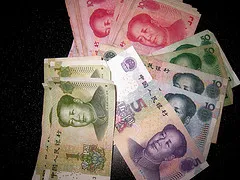
China’s local government debt amounts to a whopping $1.5-2.1trn
$300-450bn worth of local government investment vehicle loans are already in trouble.
Standard Chartered suggests transferring a large chunk of the LGIV loans to a major policy bank.
Here’s more from Standard Chartered:
| About 10,000 local government investment vehicles and their local government sponsors are sitting on some CNY 10-14trn or USD 1.5-2.1trn worth of loans. We use an estimate of CNY 14trn in this report. We estimate total government debt at some 70% of GDP at year end 2010. According to provisional figures from the China Banking Regulatory Commission, approximately CNY 2-3trn or USD 300-450bn, some 6% of GDP worth of LGIV loans are already in trouble. We go further and assume that a large portion, if not the majority, of these loans will not be repaid by the projects currently using the funds. Again, there are considerable unknowns about the scale of the potential bad debts. We believe that repayment problems will likely spread across the country, and that a formal central-government led LGIV debt-resolution mechanism will soon be required. There are signs that Beijing is already considering some kind of bailout mechanism. We outline the options that we think Beijing has available. All will involve pain that is shared among the banks, local governments and several central government organs. All will involve hard-working, thrifty households ultimately picking up the bill through a heavier tax burden, low bank deposit rates and/or inflation. But handled efficiently, the problem need not bring the broader economy to a grinding halt; the problem canbe dismantled with limited collateral damage to the banking system and economy. In the short term, increased MoF transfers to local governments – coming from an expanded budget for H2-2011 and 2012-13 – would be a relatively easy way to support these projects and maintain financial-sector stability. Then we propose transferring a large chunk of the LGIV loans to a major policy bank. It would also be possible to set up a new MoF-owned vehicle to take responsibility for these loans, a LGIV loan resolution agency. But it strikes us as sensible to ask those at the policy banks with the expertise and experience to take charge. Such a bailout framework would require a policy bank to issue a sizeable amount of new debt as well as receive considerable central-government support. We then also propose the establishment of a dedicated Infrastructure Sinking Fund, financed by excess fiscal revenues, which could be used to buy back the policy bank debt before the end of its term. Setting up a sinking fund to buy back debt early would provide investors with an added assurance that their funds will be paid back. A special inter-ministry project team will be needed to manage the extra spending and loan transfers. Cross-ministry provincial-level teams will also likely be required. Resolving the LGIV debt problem will be a slow and complicated process – it will take years. Care will be needed to ensure that cash-poor local governments do not abuse transfers of projects to the policy bank, or misuse the increased funds. The central government also needs to consider how to limit the moral hazard, of which there is more than enough already. However, as we outline in this report, we believe this problem, though large, is solvable. Given the low level of official government debt, forecast nominal GPD growth over 2011-15 of a brisk 12-15%, strong capacity in tax collection and conservative spending habits, low foreign debt and still-extensive capital controls, this problem need not trigger a banking or broader economic crisis. Critically, once the immediate challenge has been met, China needs to rebuild its fiscal and financial systems to ensure that the same mistakes are not repeated the next time an economic crisis hits. This is a huge undertaking. |
Photo from cogdogblog



![SBR 5 Lorem Ipsum News 2 [8 May]](https://cmg-qa.s3.ap-southeast-1.amazonaws.com/s3fs-public/styles/exclusive_featured_article/public/2025-05/a_hand_pointing_to_a_futuristic_technology_5b87c9d0e3_3.png.webp?itok=M3Hf-9XR)
![SBR 4 Lorem Ipsum [8 May Top Stories]](https://cmg-qa.s3.ap-southeast-1.amazonaws.com/s3fs-public/styles/exclusive_featured_article/public/2025-05/a_hand_pointing_to_a_futuristic_technology_5b87c9d0e3_2.png.webp?itok=2m5Wl0MX)


![Exclusive three SBR 12 Lorem Ipsum [8 May]](https://cmg-qa.s3.ap-southeast-1.amazonaws.com/s3fs-public/styles/exclusive_featured_article/public/2025-05/a_hand_pointing_to_a_futuristic_technology_5b87c9d0e3_11.png.webp?itok=8kn_UIfA)
![SBR 3 Lorem Ipsum [ Exclusive 2]](https://cmg-qa.s3.ap-southeast-1.amazonaws.com/s3fs-public/styles/exclusive_featured_article/public/2025-05/a_hand_pointing_to_a_futuristic_technology_5b87c9d0e3_1.png.webp?itok=YCyjLegJ)
![SBR 2 Lorem Ipsum [8 May]](https://cmg-qa.s3.ap-southeast-1.amazonaws.com/s3fs-public/styles/exclusive_featured_article/public/2025-05/a_hand_pointing_to_a_futuristic_technology_5b87c9d0e3_0.png.webp?itok=_cKD-29o)

![Video [Event News]](https://cmg-qa.s3.ap-southeast-1.amazonaws.com/s3fs-public/styles/event_news_featured_article/public/2025-05/screenshot-2025-05-08-at-4.58.53-pm_0.png.webp?itok=Kud35sMs)
![Event News SBR 9 Lorem Ipsum [8 may]](https://cmg-qa.s3.ap-southeast-1.amazonaws.com/s3fs-public/styles/event_news_thumbnail/public/2025-05/a_hand_pointing_to_a_futuristic_technology_5b87c9d0e3_8.png.webp?itok=DTh_dbYp)
![Event News SBR 9 Lorem Ipsum [8 May]](https://cmg-qa.s3.ap-southeast-1.amazonaws.com/s3fs-public/styles/event_news_thumbnail/public/2025-05/a_hand_pointing_to_a_futuristic_technology_5b87c9d0e3_7.png.webp?itok=vzDAzb6V)
![Event News SBR 8 Lorem Ipsum [8 May]](https://cmg-qa.s3.ap-southeast-1.amazonaws.com/s3fs-public/styles/event_news_thumbnail/public/2025-05/a_hand_pointing_to_a_futuristic_technology_5b87c9d0e3_6.png.webp?itok=jvHFc4P6)
![Video [Event News]](https://cmg-qa.s3.ap-southeast-1.amazonaws.com/s3fs-public/styles/video_thumbnail/public/2025-05/screenshot-2025-05-08-at-4.58.53-pm_0.png.webp?itok=yZnI0YBb)
![Video 1 SBR [8 May]](https://cmg-qa.s3.ap-southeast-1.amazonaws.com/s3fs-public/styles/video_thumbnail/public/2025-05/screenshot-2025-05-08-at-4.58.53-pm.png.webp?itok=9AAeRz_k)

 Advertise
Advertise

